Dedicating Headstones.
Images


Image text
Dedicating headstones
City to memorialize lynching victims,
acknowledge graves
By Susan Hogan/Albach
News-Tribune staff writer
“I have
heard a man say the only thing he regretted about the (lynching) affair was that
those negroes were buried and thereby spoiled a perfectly good piece of
ground.”
Letter to Editor, Duluth Herald,
1920
Seventy-one years after a Duluth mob lynched three black circus
workers, the city will memorialize the victims by dedicating headstones and, for
the first time, will publicly acknowledge their graves.
Deterred but not
defeated” read the newly erected headstones of Elias Clayton, Isaac McGhie
and Elmer Jackson, whose recently located graves are in a grassy area of Park
Hill Cemetery in the Hunter’s Park neighborhood.
The procession of
hate-filled people that dragged the victims from their jail cells, then beat and
hanged them in 1920, will be countered today by a peaceful procession to the
cemetery beginning at 12:15 p.m. at the Central Hillside Community Center, 12 E.
Fourth St. The dedication begins at 1 p.m.
The Rev. Rolf Olson, pastor of
First Lutheran Church, and several dignitaries will speak at the service. First
Lutheran owned the Norwegian Lutheran cemetery at the time of the lynching and
ensured the victims’ burial despite the explosive
climate.
“There was so much hate that nobody could have stopped those
nuts,” said Elmer Glenn, who was 14 years old in 1920. Glenn is the only
member of Duluth’s black community known to have lived here at the time of
the lynchings.
“We were scared,” he said. “There was a lot
of talk that the whites were going to wipe out all the blacks.”
The
atmosphere was so volatile then that Minnesota’s governor sent the state
militia here to keep order and protect the city’s 495 blacks. About 750
blacks now live in Duluth, according to census reports.
Today’s
ceremony is an outcry against the racial violence that continues here as
evidenced in February when two predominantly black churches were spray painted
with racial epithets.
But it is also a tribute to the stalwart individuals
whose words and actions challenge racist behaviors and attitudes. In the wake of
the 1920 lynchings, newspaper accounts describe clergy “as the most
fearless” in the battling racism, including:
■The Rev. W.J.
Powers, a Catholic priest who climbed the light pole where the lynchings would
occur and pleaded with the crowd, estimated at 5,000 to 10,000 people. At the
same time, his colleague, the Rev. P.J. Maloney, walked through the mob begging
individual to end the violence.
“Let the law take its course,”
Powers cried. “In the name of God and the church I represent, men, I ask
you to stop.
■The Rev. George Brewer, pastor of First Presbyterian
Church, who offered an impassioned sermon titled “Why These Crimes and
Lynchings” in which he condemned the hangings.
■The Rev. A. W.
Ryan, rector of St. Paul’s Episcopal Church, who joined with
Duluth’s Kiwanis Club in publicly denouncing the lynchings.
“We
trust that every good man and true will lift up his voice in bitter condemnation
of such a disgraceful act,”
Please see Markers, Page 6B
[photo caption] Grave markers for the three men who were lynched by a Duluth
mob in 1920 are in place in Park Hill Cemetery.
Markers: City to
dedicated headstones
From Page 1B
he said. “Duluth now
stands shamed in the eyes of the world.”
No public statements are
recorded from members of First Lutheran Church, who instead quietly say to the
victims’ burial.
“Somebody made the decision to welcome into
this white, Scandinavian cemetery three black men who had suffered such
indignity.” Olson said. “This effort now to dignify the very
undignified death of these men by putting gravestones there, builds on a
tradition of compassion that was manifested in 1920 by the decision to move the
bodies to Park Hill Cemetery.”
Many believed the victims were buried
in a potter’s field near the old Cook Home in Duluth Heights until last
summer’s debate over a proposed jail there. After it was learned the
victims were in unmarked graves at Park Hill, an effort was initiated by members
of First Lutheran Church and the Duluth Chapter of the National Association for
the advancement of Colored People to erect headstones.
Today’s
ceremony is in conjunction with the NAACP’s annual freedom fund banquet,
which begins at 6 p.m. to the Holiday Inn, 200 W. First St. The 1920 lynchings
led to the beginning of the Duluth NAACP branch.
“The markers bring
closure to tragic event and are a painful reminder of racial violence,”
said Bob Baldwin, Duluth’s NAACP president. “Unfortunately, racism
is still prevalent in our society and in this community.”
Craig Grau,
a member of First Lutheran Church, initiated the effort that led to the
installment of markers. The university of Minnesota-Duluth political science
professor has compiled additional research about the event that isn’t
documented in the only book written about the violence, Michael Fedo’s
“They Was Just Niggers.”
The deaths of the circus workers for a
crime doctors’ reports indicated never happened was felt nationwide, and
its impact is still being measured.
The mob violence let the Minnesota
Legislature to pass anti-lynching laws. Elisha Scott, a black lawyer from
Topeka, Kan., who tried unsuccessfully to sue the Duluth Police Department on
behalf of a victim’s father, was later involved in a landmark case in
which the Supreme Court ruled that racial segregation in public schools was
unconstitutional.
Roy Wilkins, then a student a the University of Minnesota,
said of the Duluth lynchings in his autobiography: “I lost my Innocence on
race once and for all.” Wilkins later became executive secretary of the
national NAACP.
Closer to home, Alfred Weinberg of Duluth, who was 12 when
he witnessed the lynchings, said the event shaped his law career as an adult.
Weinberg said he often took on black clients without charging a
fee.
“It was a terrible thing to see, particularly for a
youngster,” said Weinberg, who is now retired. “I was never the same
and developed very strong views about the rights of
minorities.”

